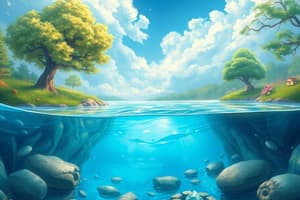Podcast
Questions and Answers
Which of the following correctly describes the composition of a water molecule?
Which of the following correctly describes the composition of a water molecule?
- It is made up of three hydrogen atoms and one oxygen atom.
- It contains one oxygen atom and two nitrogen atoms.
- It is composed of one hydrogen atom and two oxygen atoms.
- It consists of two hydrogen atoms and one oxygen atom. (correct)
What is the significance of water's polarity in relation to its chemical properties?
What is the significance of water's polarity in relation to its chemical properties?
- It allows water to remain neutral in pH across all conditions.
- It makes water non-polar, which aids in dissolving organic compounds.
- It causes water to have a single charge and act as a solute.
- It enables water to dissolve ionic compounds and form hydrated ions. (correct)
What is the correct process that occurs during the condensation phase of the water cycle?
What is the correct process that occurs during the condensation phase of the water cycle?
- Water vapor cools down, forming droplets that contribute to cloud formation. (correct)
- Water runs off the surface and enters underground reservoirs.
- The sun heats water, causing it to evaporate into vapor.
- Liquid water gets converted into solid ice deposited on the ground.
In the context of hydrolysis, which of the following statements is true regarding the pH of the resulting solutions?
In the context of hydrolysis, which of the following statements is true regarding the pH of the resulting solutions?
Which of the following correctly outlines the contribution of the hydrosphere to Earth's surface?
Which of the following correctly outlines the contribution of the hydrosphere to Earth's surface?
What is the pH range for freshwater?
What is the pH range for freshwater?
What is the primary purpose of monitoring salinity levels in natural water bodies?
What is the primary purpose of monitoring salinity levels in natural water bodies?
How does the density of pure water change as its temperature decreases from 4°C to freezing point?
How does the density of pure water change as its temperature decreases from 4°C to freezing point?
Which of the following best describes the function of a hydrometer?
Which of the following best describes the function of a hydrometer?
What factors primarily influence water density in oceans?
What factors primarily influence water density in oceans?
Flashcards are hidden until you start studying
Study Notes
Water Properties and their Influence
- Water dissolves most chemical compounds due to its unique polarity.
- Water exists in three states: solid (ice), liquid (water), and gas (water vapor).
- The hydrosphere comprises all the water on Earth, with 72% of Earth's surface covered by water.
- 97% of Earth's water is saltwater found in oceans and seas.
- 3% is freshwater, with 1% originating from groundwater sources.
Water Cycle
- Water continuously cycles through evaporation, condensation, and precipitation.
- This cycle, also known as the hydrologic cycle, influences Earth's chemical, physical, and biological characteristics.
Chemical Composition of Water
- Water is composed of two elements: hydrogen and oxygen.
- Two hydrogen atoms bond to one oxygen atom through covalent bonds.
- The bond angle is approximately 104.5 degrees.
Water Polarity
- Oxygen has higher electronegativity than hydrogen, causing electrons to be attracted to oxygen atoms.
- This creates a partial negative charge on oxygen and partial positive charges on hydrogen atoms.
- Water's polarity allows it to form hydrogen bonds, enabling the dissolution of salts into hydrated ions.
Hydrolysis
- Hydrolysis is a chemical process where a water molecule breaks down a compound into smaller components.
- NaCl (hydrolysis): Neutral solution - [H+] = [OH-]
- NaHCO₃ (hydrolysis): Basic solution - [H+] < [OH-]
- NH₄Cl (hydrolysis): Acidic solution - [H+] > [OH-]
pH Value
- The pH value measures the acidity or basicity of a solution.
- pH < 7: Acidic solution
- pH = 7: Neutral solution
- pH > 7: Basic solution
pH Values of Common Substances
- Seawater: 7.5 to 8.4
- Freshwater: 6.5 to 8.5
- Distilled water: 7
- Groundwater: Varies according to the type of rock
Practical Activity for pH
- To measure pH, collect water samples from different sources.
- Fill beakers with the samples and use a pH meter or pH test strips.
- Calibrate the pH meter before use.
- Immerse the electrode in the water samples and record the readings.
Monitoring Salt Hydrolysis in Water Bodies
- Monitor salinity levels regularly to assess the impact of salt hydrolysis on water quality.
- Track changes in ionic composition to understand how salt breakdown affects water quality.
- Implement effective waste management practices to minimize salt pollution.
- Protect water quality for both wildlife and human use.
Water Density
- Density is the mass of a unit volume of matter at a given temperature.
- Density depends on the mass of molecules and their spacing.
- The density of pure water is 1 g/cm3 or 1000 kg/m3.
- Water's density decreases as temperature decreases from 4oC to the freezing point.
- A hydrometer, containing weighted balls and a calibrated stem, measures the density of liquids.
Water Density and Ocean Currents
- Ocean water density is influenced by pressure, salinity, and temperature.
- Pressure increases with depth, causing compression and increased density.
- Salinity affects density as dissolved salts increase water's density.
- Temperature plays a significant role, as colder water is denser.
Hydrometer Usage
- Use a hydrometer to measure the density of water samples from different sources.
- Analyze its application to predict the presence of soluble pollutants in water samples.
Studying That Suits You
Use AI to generate personalized quizzes and flashcards to suit your learning preferences.




